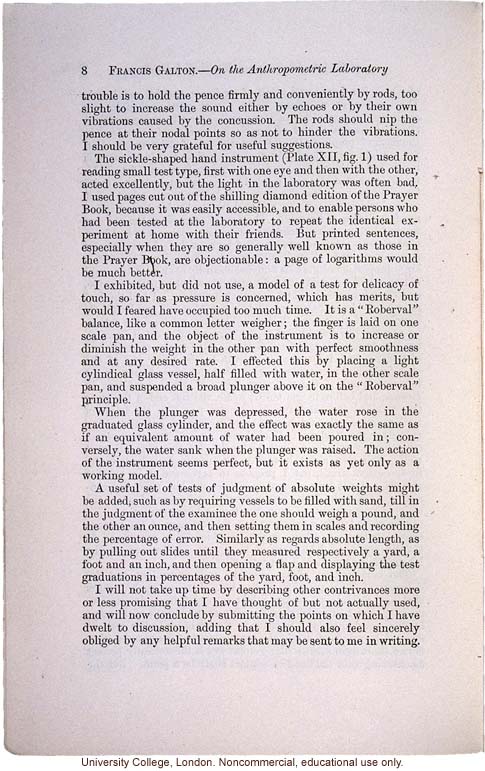8 Francis Galton. - On the Anthropometric Laboratory
trouble is to hold the pence firmly and conveniently by rods, too slight to increase the sound either by echoes or by their own vibrations caused by the concussion. The rods should nip the pence at their nodal points so as not to hinder the vibrations. I should be very grateful for useful suggestions.
The sickle-shaped hand instrument (Plate XII, fig. 1) used for reading small test type, first with one eye and then with the other, acted excellently, but the light in the laboratory was often bad. I used pages cut out of the shilling diamond edition of the Prayer Book, because it was easily accessible, and to enable persons who had been tested at the laboratory to repeat the identical experiment at home with their friends. But printed sentences, especially when they are so generally well known as those in the Prayer Book, are objectionable: a page of logarithms would be much better.
I exhibited, but did no use, a model of a test for delicacy of touch, so far as pressure is concerned, which has merits, but would I feared have occupied too much time. It is a "Roberval" balance, like a common letter weigher; the finger is laid on one scale pan, and the object of the instrument is to increase or diminish the weight in the other pan with perfect smoothness and at any desired rate. I effected this by placing a light cynlindrical glass vessel, half filled with water, in the other scale pan, and suspended a broad plunger above it on the "Roberval" principle.
When the plunger was depressed, the water rose in the graduated glass cylinder, and the effect the same as if an equivalent amount of water had been poured in; conversely, the water sank when the plunger was raised. The action of the instrument seems perfect, but it exists as yet only as a working model.
A useful set of tests of judgment of absolute weights might be added, such as by requiring vessels to be filled with sand, till in the judgment of the examinee the one should weigh a pound, and the other an ounce, and then setting them in scales and recording the percentage or error. Similarly as regards absolute length, as by pulling out slides until they are measured respectively a yard, a foot and an inch, and then opening a flap and displaying the test graduations in percentages of the yard, foot, and inch.
I will not take up time by describing other contrivances more or less promising that I have thought of but not actually used, and will now conclude by submitting the points on which I have dwelt to discussion, adding that I should also feel sincerely obliged by any helpful remarks that may be sent to me in writing.
[end]


